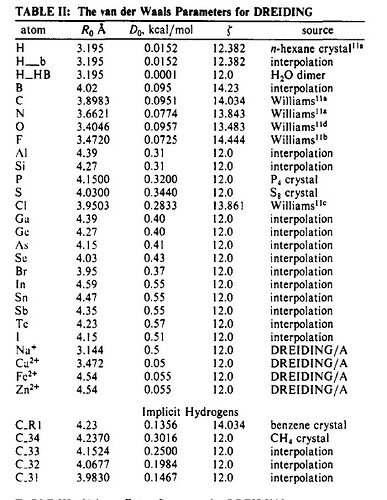Sir,
I understand your time is precious. But, my concern is how to implement hybrid potential, where I can implement PCFF potential for my polymer matrix, extep for Boron nitride and Lj for interaction. I also found a paper after getting your mail where the authors implement PCFF for polymer matrix, tersoff for Boron nitride and LJ for interaction.
…and if I had reviewed that paper, I would have suggested rejecting it because of the ill-conceived model. The authors even explicitly admit to it by stating that they disregard and charges on the BN compound without providing proof that their approximation is valid. I do understand why they are doing this, because there is no clean way to combine a tersoff or similar potential for a polar material with a conventional force field, but that doesn’t make it a valid model.
I would also be concerned about the validity of the tersoff potential parameters for a nano particle as its parameterization strategy and potential function does not account for changes in polarization at the surfaces, edges and corners. There is the classical - and more extreme - example of a tersoff potential for SiO2, which will simply not produce stable systems outside of bulk setups. Simulating such systems usually requires some kind of method to handle the change in polarization due to the geometry like it is done with charge equilibration methods. There are manybody force fields that include those.
If I am not able to implement the proper science then please help me because I don’t have any advisor/tutor who is knowledgeable as you are.
That is not a valid argument. First off, I am not in a position where I can accept students to advise and I am not interested to do it but most certainly I have not agreed to do it.
That said, there are people far more knowledgeable in this area of research than me, so by your reasoning you should ask those, not me. Your lack of understanding of basic MD force field physic is quite significant and that you should be able to learn from anybody with some experience in the field. Otherwise that person would not be competent to supervise a project like yours.
Sir, where you are, you might get interacted with only brilliant students or people but there are other countries, other places in the world where the students are poor or average and they are lacking technology. I am not asking you to teach me but at least you can guide me with reference paper or books from where I can learn the solution of my problem and also I can acquire the proper science of molecular simulation.
Sorry, what you are asking is contradicting itself. If I do what you ask me to do, I will act as your adviser with having all the effort but without any of the benefits.
Sir, it’s not like that, that I posted my question directly on lammps mailing list. Before this, I tried very hard. I also searched on the internet, read so many journals but I failed to get any idea that how to solve my problem. Even, I am trying yet also.
How much effort you have invested is irrelevant. The problem is that you are taking on a problem that is far beyond your level of understanding. You need to start with something less demanding and build your skills. This is something that your adviser should be aware of and guide you appropriately. If your adviser does not possess the experience or skills to oversee every detail of your project, then he or she would have to search for a suitably competent collaborator on that project. That is how this is done in science. Unfortunately, it has become quite common that advisers let their students do projects that are beyond their training level and are relying on online forums and other means to make up for their own shortcomings. But similarly, it has become common for students to plead with people in online forums for guiding their research rather than demanding the proper advising and training for their project from the person responsible, i.e. their adviser. If your adviser is not willing to address this issue you should ask for a different project or look for a different adviser. It is most certainly not the responsibility for people like me to resolve this. Like other researchers, I have the liberty to choose what I am working on within the confines of the position I am hired on.
I apologize if my words hurt you in any manner.
I am not offended, but just annoyed. This is a discussion that should not have happened if you had proper advising and training and then would have approached your project in a proper way.
